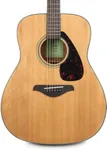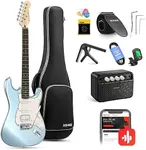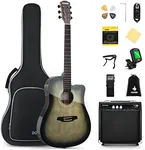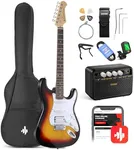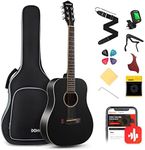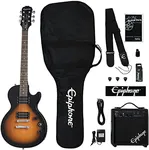Buying Guide for the Best Guitar For Beginners
Choosing your first guitar is an exciting step, and it's important to find one that feels comfortable and inspires you to play. As a beginner, you want an instrument that is easy to handle, sounds good, and suits the style of music you want to learn. Focus on playability and comfort rather than advanced features, and remember that the right guitar can make learning much more enjoyable.Type (Acoustic vs. Electric)The type of guitar you choose—acoustic or electric—will shape your learning experience. Acoustic guitars are self-contained and don't need extra equipment, making them great for portability and simplicity. Electric guitars are easier to play because of their lighter strings and slimmer necks, but they require an amplifier. If you like rock, blues, or metal, an electric might be more motivating, while acoustic is great for folk, pop, or singer-songwriter styles. Think about the music you want to play and where you'll practice most often to guide your choice.
Body Size and ShapeGuitars come in various body sizes and shapes, which affect comfort and sound. Smaller bodies (like parlor or concert size) are easier for beginners, especially younger players or those with smaller hands, while larger bodies (like dreadnoughts) produce a louder, fuller sound but can be bulky. Try holding different sizes to see what feels comfortable, as ease of handling will help you practice longer and with less strain.
Neck Profile and WidthThe neck profile and width determine how the guitar feels in your hand. A thinner neck is easier for small hands and beginners, making it simpler to form chords. Wider necks can be challenging at first but may be preferred for fingerstyle playing. Test a few guitars to see which neck shape feels most natural for your grip and playing style.
String Type (Nylon vs. Steel)Guitars use either nylon or steel strings. Nylon strings, found on classical guitars, are softer and easier on the fingers, making them a good choice for young beginners or those with sensitive hands. Steel strings are brighter and louder, common on acoustic and electric guitars, and are better for most modern music styles. Consider your finger sensitivity and the type of music you want to play when choosing string type.
Action (String Height)Action refers to how high the strings are from the fretboard. Lower action makes pressing the strings easier, which is helpful for beginners, but if it's too low, you might get unwanted buzzing. Higher action can be harder to play but gives a cleaner sound. Look for a guitar with comfortable, medium-low action to start, and know that a guitar shop can adjust this if needed.
Tuning StabilityA guitar that stays in tune is crucial for learning, as constant retuning can be frustrating. Good tuning stability comes from quality tuning pegs and a well-made neck. When trying guitars, check if they hold their tuning after a few minutes of playing. This will help you focus on learning rather than tuning.
Weight and BalanceThe weight and balance of a guitar affect how comfortable it is to hold, especially during longer practice sessions. Lighter guitars are easier to manage for beginners, while a well-balanced guitar won’t tip forward or backward when you play sitting down. Pick up the guitar and see how it feels in your lap or on a strap to ensure it’s comfortable for you.
